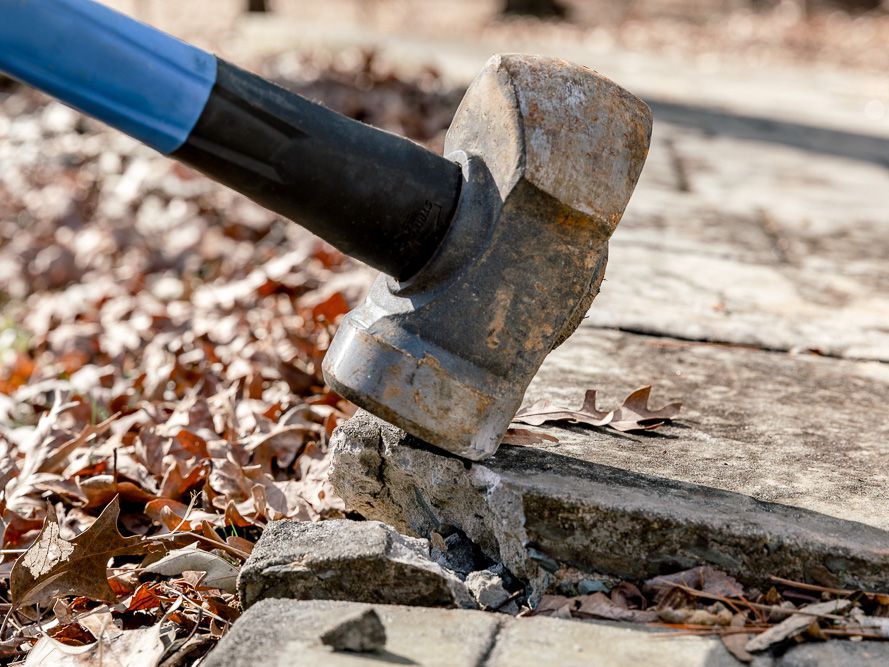Breaking concrete may seem like a simple task. However, there is more to it than just hitting the concrete with full force. In fact, there can be a few complications involved if you’re not careful.
Therefore, we recommend that you take a few things into consideration before you start. These are the thickness of your slab, your disposal strategy, and whether you can use electric tools or not.
So here’s a step-by-step guide to make the job safe and easy for you. Read ahead and go get your tools already!
Call Your Local Utility Companies
Before starting with any of the work, make sure that there are no utilities running underneath the concrete. It’s very probable that you find a gas line or a water pipe running beneath the slab. You can call your local utility companies and find out where your utilities are located.
If there’s a pipe going beneath your concrete slab, then breaking it up yourself can be very dangerous and lead to a plumbing emergency. We suggest that you hire a professional in this case.
Choose Your Breaking Tool
Once you’ve ensured that your slab is safe to break, it’s time to choose an appropriate tool.
Money is an important factor when you’re deciding on a suitable tool but it’s not the only one. Be sure to also consider your experience with a tool and the thickness of your slab when making your choice.
There are plenty of tools that you can use for breaking concrete slabs. Here are a few examples:
- Sledgehammer: It’s the most easy-to-use tool for breaking concrete, and is usually used for breaking thin concrete slabs. If your slab is about 3 inches thick, this is the tool for you. However, keep in mind that using a sledgehammer requires great physical effort.
- Electric Jackhammer: This is an electro-mechanical tool that is easily available for rent. It is used for medium slabs (3 inches thick or more). And although it requires much less physical effort than a sledgehammer, it’s not as easy to use. So make sure to read all the instructions and take safety precautions prior to its use.
Now, we’ve talked about thin and moderately thick slabs. But what to do if you have a particularly thick one? A pneumatic jackhammer is the best tool in this case, but it can be complicated to use if you don’t have experience. So it’s recommended that you leave this job to a professional.
Other than a breaking tool, you’ll need:
- A pry bar
- Shovel
- Bolt cutters or a reciprocating saw
- Hand truck or a wheelbarrow
- Contact information of a rubbish removal company, such as 1300 Rubbish
Break Up The Slab
Now that you have all the necessary tools, it’s time to break up the slab. Put on gloves to protect your hands from blisters and get started.
Breaking up a concrete slab can be a tough job, but there are a few tips and tricks that can make it easier.
First of all, cover the concrete with a plastic sheet if you’re working indoors or near a window. This will help save nearby objects from damage.
Secondly, always start breaking the concrete from near the edge. It will break away more easily in chunks this way.
Also, cracks may appear shortly afterward you start hammering but don’t be fooled by them. The concrete may appear to be broken, but the chunks are still locked together.
To tackle this problem, you should stop breaking the concrete when you’re 2-3 ft inside from the edge. Use a pry bar to open the cracks and separate the chunks. You may also find reinforcing steel mesh inside the concrete. Use bolt cutters to cut them. Your concrete may also be reinforced by rebars, for which you’ll need a reciprocating saw.
To save time and effort, you can have a partner help you by separating the chunks while you work your way in.
Tips On Using Breaking Tools
If you’re using a sledgehammer, don’t start hammering the concrete directly. With each blow, most of the energy will be absorbed by the soil beneath. And this will result in a waste of time and energy.
Instead, try to get your shovel slightly beneath the edge of the concrete. Next, dig out some soil from under the slab and make a small void. This makes it easier to break the concrete.
If you’re not able to dig beneath the slab, then you can start hammering the concrete directly. When a few cracks appear, use a pry bar to lift up the concrete chunks and continue with the hammering. This will make the process easy.
On the other hand, if you’re using a jackhammer, do not drill in a diagonal direction. Instead, keep the jackhammer perfectly upright. Also, drill on a few focus points around the edge until it breaks. You can watch this video for a better idea.
Dispose Of The Junk
This is the final but important step of breaking up a concrete slab. Usually, the trash collector doesn’t pick up junk like concrete chunks. Therefore, you’ll have to take other measures to dispose of these.
You can drive to the council tip, and dump the concrete there yourself. However, there may be some charges for this, so make sure to talk to your local council before. You can also contact a disposal company and rent a dumpster from them.
To carry the junk to a container, you’ll need a wheelbarrow or a hand truck, so make sure to have one beforehand. A hand truck would be a better choice, as you’ll only have to lift the concrete chunks 1-2 inches above the ground.

